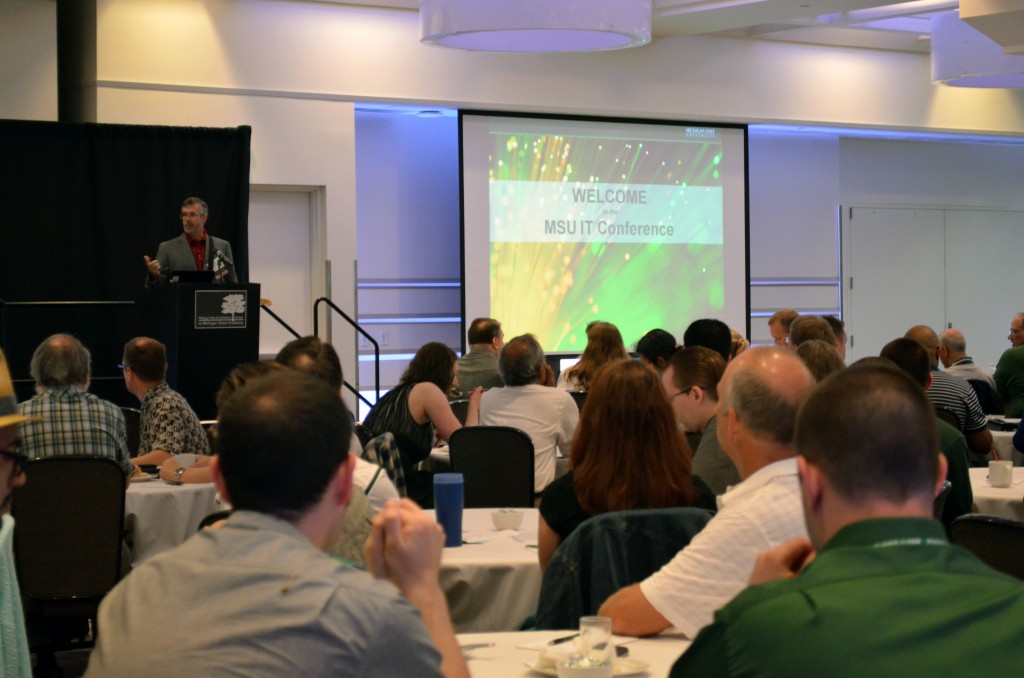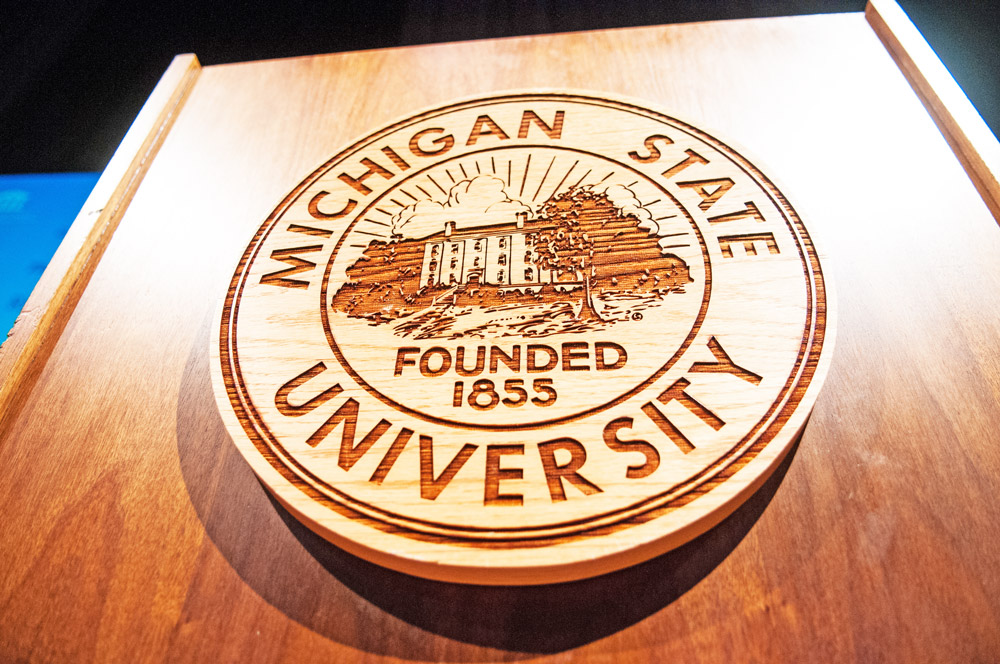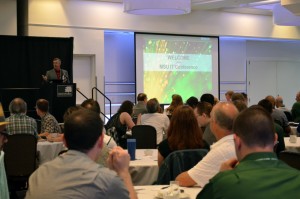About 215 attendees participated in the 2013 MSU IT Conference held on June 12 at the Kellogg Center.
IT Services hosts an annual IT Conference to recognize and share creativity and forward-thinking contributions made by information technology and the people behind the technology at Michigan State University.

Acting CIO Tom Davis kicks off the 2013 MSU IT Conference on June 12.
Cybersecurity matters
Dan Lohrmann, Chief Security Officer for the State of Michigan, opened the conference with his Morning Keynote “Cybersecurity: Your Future, Your Cloud and Your Smartphone.” Interspersed in his presentation were chances for each table to discuss different cybersecurity issues they were seeing.
Lohrmann shared his top three list of cybersecurity concerns that keep him awake at night. These include:
- Cloud Computing
- Bring Your Own Device (BYOD)
- A Need for Culture Change
Cloud computing has huge implications for people with mobile devices, Lohrmann explained, but there has to be a balance for IT staff and users between blind trust and control. Some key cloud computing questions surround who owns the data and where the data is hosted.
With BYOD, he said, we need to make it easy for users to do the right thing. “We cannot be naysayers with mobile. People will just go around us.”
Changing a culture in hard, said Lohrmann, but as IT professionals we need to increase cybersecurity awareness and training for end users. “We need to be enablers. Security has got to be at the table and in discussions.”
“If you get the process and the people right, the technology usually comes along.”
Security incidents and mental models
In addition, there were two Breakout Sessions on cybersecurity. “Security Incidents and Reporting” was panel presentation. Lohrmann shared some cybersecurity threats for the State Michigan and how it responds. Additionally, the MSU Police and the IT Services Network Management team walked participants through the process of investigating a suspected compromise of a data system.
The other session, “Mental Models of Security,” featured speakers from the Department of Telecommunication, Information Studies and Media, and the School of Journalism and Department of Telecommunication, Information Studies and Media. This session used research to look at how non-experts think about the security threats they face and pose some non-traditional ideas that IT professionals can use to help students, faculty, and staff react better to phishing, pharming, and web-based attacks.
SynchroModal learning
Other breakouts included College of Education Faculty Member Dr. John Bell discussing his SynchroModal learning model for increasing engagement and participation of online learners in a class that also includes face-to-face students.
Bell and some of his graduate students who serve as Technology Navigators described SynchroModal examples from the Educational Psychology and Educational Technology (EPET) Hybrid Ph.D. program in the College of Education.
Technology plays a large role in these classrooms and planning and testing were necessary, as they tried to integrate face-to-face and online learning as comparable components. It took collaborating closely with the learning side of the house, as well as the IT side to come up with technology solutions, said Bell.
“Leading with a solution rather than a problem only succeeds by chance,” said Bell. “What primary problem are we trying to solve?”
A focus was on the use of personal portals that help online students maintain a participatory presence within a physical classroom using tools like iPads, Go To Meeting, and Skype.
Data management
Bill Yock, director of Information Services at the University of Washington presented the Afternoon Keynote on data management.
Yock also participated in a Breakout Session panel on “Analytics for Enterprise Efficiency and Effectiveness” with Don Ries, MSU IT Services Enterprise Information Stewardship. In this session, Yock and Ries discussed ideas and plans to leverage enterprise data demands with effective governance, dashboards, and collaboration.
Other sessions
Additional Breakout Sessions included an update from the MSU Web Team on Responsive Web Design and a presentation on how virtual desktops are being used on campus by Communications and Brand Strategy, Health Information Technology, and Community, Agriculture, Recreation, and Resource Studies.
Bolder IT
Tom Davis, acting CIO of Information Technology at MSU, gave the Closing Remarks. Davis provided some background on disruptive changes happening in higher education now and on MSU’s Bolder by Design strategic direction.
“In the midst of changes, there are opportunities,” he said, adding that we want to put together a plan to overcome some of the challenges faced by the IT community.
During his remarks, Davis encouraged tables to work together to answer: “How can IT at MSU be bolder?” Some of these answers were shared back with the larger group. All the answers were collected with the plan to compile and post them online.
Davis encouraged the room to look at the broader picture of IT at MSU. We are all in this together and need to get rid of barriers to collaboration.
“Hold us accountable,” Davis said. “We are really trying to improve. Keep the feedback coming.”
More information
Most of the 2013 MSU IT Conference presentations are posted online. The Twitter hashtag was #msuitc13. There is also information on the 2013 MSU IT Conference Lanyrd site.



